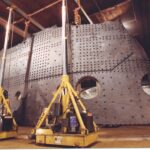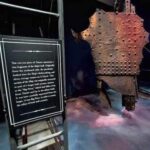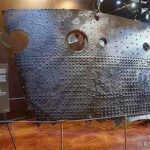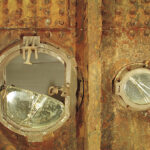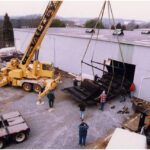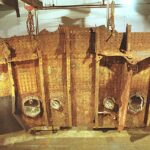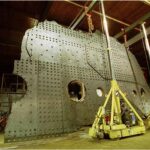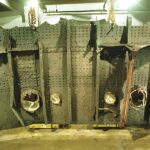THE BIG PIECE
CONTRIBUTED BY BILL WILLARD
THE MEETINGS
Consulting with IFREMER, and project specialist Pierre Valdy, a plan was developed. During the upcoming 1996 Expedition, Nautile would secure the hull piece with cables that would later be attached to floatation bags, and upon release, the flotation bags would lift the piece to the surface. A recovery vessel was needed, and through an agent in Canada, the MV Jim Kilabuk was recommended. PH Nargeolet flew to see the ship and it was determined that the ship’s winch needed an upgrade. Before leaving, an agreement – written into the contract – called for the addition of a crane. This work would be approved by all official insuring parties, and enable the Kilabuk to recover the piece safely and efficiently.
Eagerly, George Tulloch and PH Nargeolet looked forward to the expedition. A side project had two cruise ships circling the recovery vessels as Nautile attached the cables to the recovery bags. Several thousand eyewitnesses stood at the rails as the signal was given to release the floatation bags from their ballast weights, and the piece slowly began to rise. It would take over two hours to ascend. Onlookers cheered as the green and red bags appeared on the surface.
THE BIG LIFT
The Kilabuk arrived on site several hours before the ascension as scheduled, but to RMSTI’s surprise, the crane adaptation had not occurred. The Kilabuk manoeuvered into position near the lift bags. The captain maintained his ship could do the recovery with his winch. Several hours later, amid significant frustration, all parties had to revisit the plan. The Kilabuk’s winch was insufficient. The solution chosen was to let the Big Piece ‘free hang’ from the stern of Kilabuk, while the ship would engage a course to Halifax, where a different recovery could be used. During the evening, storm surges from Hurricane Edward forced the team to release the Big Piece, and it dropped back to the ocean floor. A transponder, still attached, would relay the coordinates.
In 1998, the expedition team’s first objective was to complete what was started in 1996. The lift bags were reattached to the Big Piece, and this time a new ship, the Abeille Supporter, capable and ready for recovery, sat with team members anxiously awaiting the arrival. The signal was given and the lift bags were released from their ballasts, and a short while afterwards, the piece released from the mud, and began to rise. The lift bags surfaced, and diver (and television producer) Bob Sitrick did a visual inspection. The Abeille manoeuvered into position, attached itself to the Big Piece, and the winch began to pull.
As the Big Piece broke the water, many were immediately hit with conflicting emotions. Excitement and joy of the recovery were replaced by sadness and reverence. THIS was a piece of Titanic. THE Titanic. And it was in the sun’s light again for the first time since 14 April 1912.
The Big Piece was carefully placed upon the deck of Abeille. One could immediately see the different colours of the rusticles, then notice the smells coming from the chemical reactions in place. A hose was set up to constantly spray the metal with water to keep it moist.
The Big Piece went into conservation in Boston, and eventually was separated into two parts because of concerns with transportation and exhibiting. The main hull piece was intact, and a small extending piece was now independent.
Eagerly, George Tulloch and PH Nargeolet looked forward to the expedition. A side project had two cruise ships circling the recovery vessels as Nautile attached the cables to the recovery bags. Several thousand eyewitnesses stood at the rails as the signal was given to release the floatation bags from their ballast weights, and the piece slowly began to rise. It would take over two hours to ascend. Onlookers cheered as the green and red bags appeared on the surface.
THE EXHIBIT
The Big Piece traveled for several years. Those who saw the exhibits marvelled in its presence. Many were overcome with emotion. Many shed tears. Some have reported touching it – and feeling ‘tingling’. Gazing at this immense section of the hull brings many people closer to Titanic. It makes the story real and tangible, and not just legend. Sitting in the observation rooms, one can see the effect it has on many of the visitors to the exhibitions. This
was what George Tulloch envisioned – giving the people this gift to FEEL Titanic – not necessarily to touch it – but to FEEL Titanic through vision, emotions, and senses.
The Big Piece is on display in The Titanic Artifact Exhibit in the Luxor Hotel, Las Vegas, Nevada. The Little Piece can be seen in The Titanic Artifact Exhibit in Orlando Florida.
Eagerly, George Tulloch and PH Nargeolet looked forward to the expedition. A side project had two cruise ships circling the recovery vessels as Nautile attached the cables to the recovery bags. Several thousand eyewitnesses stood at the rails as the signal was given to release the floatation bags from their ballast weights, and the piece slowly began to rise. It would take over two hours to ascend. Onlookers cheered as the green and red bags appeared on the surface.

